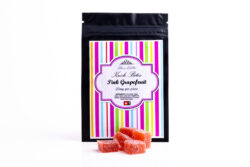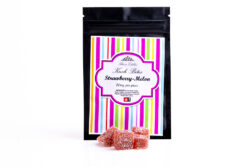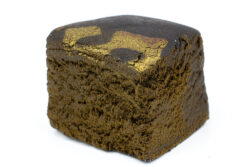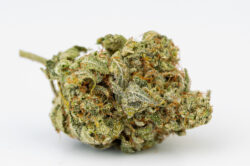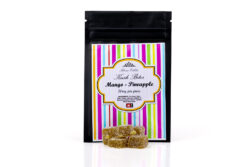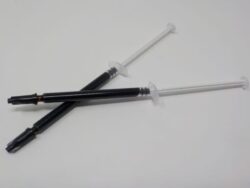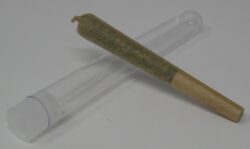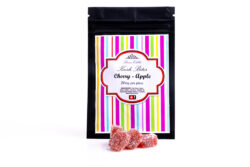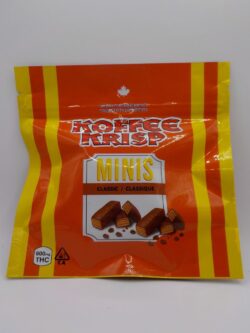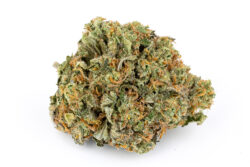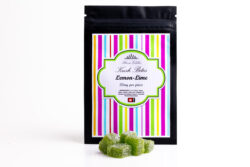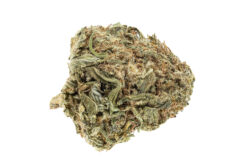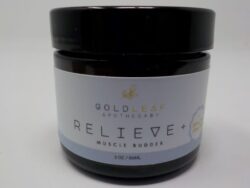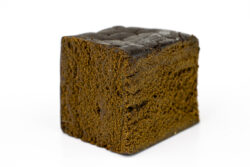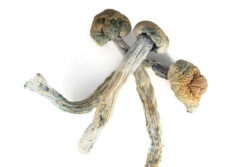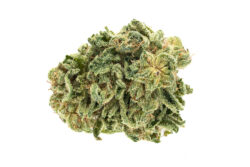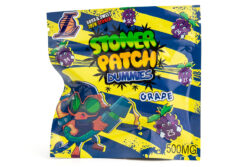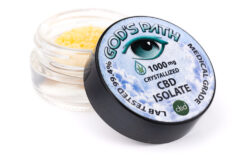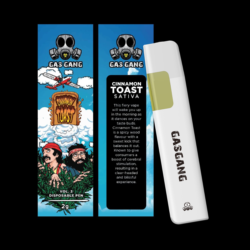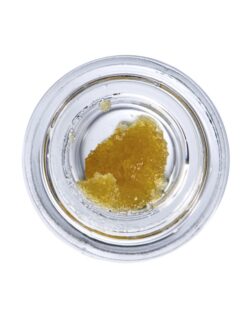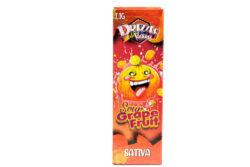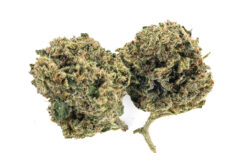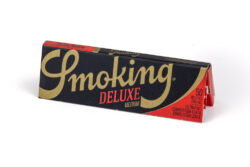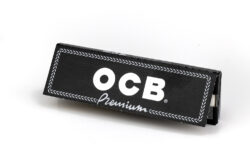As an adult, Cozzolino made buying Turkish delights from a neighborhood candy store an after-school ritual he shared with his son.
‘Infinite possibilities’
As an infused cannabis product, Turkish delights can be as practical as they are magical, he said.
“The formulation gives infinite possibilities in terms of the types of ingredients that you can use. You can throw anything at it and make it make sense and make it taste good,” said Cozzolino, who started the California-based cannabis company Rose Los Angeles in 2017.
Rose Delights, the brand’s marquis product, are cannabis-infused Turkish delights. Rose Los Angeles also sells packaged flower, infused chocolates and capsules.
“It gives you an opportunity to create a more shelf-stable, gummy type of product without having to introduce all sorts of weird synthetic or artificial ingredients,” Cozzolino said.
Cozzolino’s culinary team and occasional guest chefs have created an exotic selection of homegrown flavors infused with single-strain rosin from flower grown on Rose’s Farm in Penn Valley, California.
The farm also grows many of the fruits and vegetables that go into the delights. Ingredients not grown on the farm are sourced from local farmers and specialty producers.
Flavors of Rose Delights include apple-ginger-ume (a Japanese fruit similar to a plum) infused with Sunshine No. 4 rosin, pear-kimchi infused with Maltese orange rosin and, in a nod to the traditional Turkish delight, two types of rose hibiscus: one infused with Fruit Gushers (an indica strain) and the other with Super Lemon Mac (a sativa).
“The whole intention behind Rose Delights was to create an edible product that took responsibility for and cultivated the majority of its inputs,” Cozzolino said.
Farm and flower
The process begins at Rose’s Farm, a property in central California that includes a 10,000-square-foot cannabis garden.
Rose Los Angeles uses only a fraction of the garden to grow roughly 300 plants, which typically yield about 500 pounds of dry cannabis.
Of that, 100 pounds is selected for manufacturing rosin, which will go into Turkish delights or chocolates, and the rest is sold as packaged flower.
If Rose maxed out its grow space, it could harvest more than 1,000 pounds of flower and produce 30,000 packages of Rose Delights per month, Cozzolino said, adding: “We just focus on the genetics that are inspiring.”
Cozzolino noted that Rose uses the same grades of flower for rosin pressing that it sells as packaged bud.
“Whether we’re packaging it for prepackaged flower sales or we’re putting it in a 35-micron bag for pressing, the process all the way up until the very end is exactly the same. So, all of our flower is treated like smokable flower,” he said.
“It’s all graded similarly; we’re not only pressing smalls, we’re pressing 7-gram buds.”
After harvesting, the flower is cured for 10-14 days and then stored in bins separated by strain. It often won’t be trimmed until it’s ready for sale or pressing.
Rose’s trimmers are careful not to overtrim buds, which can cause unnecessarily trichome loss.
“For pressing, we want to preserve those. But we get off anything that could affect the flavor—so anything that’s not trichrome-encrusted. And then, a lot of the sugar leaf goes away as well. We take it down pretty close to just the bud,” Cozzolino said.
“We pretty much process that same exact way that you would process to package smokable flower, except instead of putting it in flower packaging, we put it into a nylon mesh bag for pressing.”
Pressed to impress
The flower then goes to Rose’s 3,000-square-foot facility in San Francisco’s Mission District, where it is pressed.
The facility also is home to Rose’s kitchen, where the edibles are made, as well as a curing room where the delights are cured.
For pressing, the flower is put in 35-micron bags (about the size of a single human hair, Cozzolino said) that can hold up to a half-pound of flower.
Rose uses Sasquatch Yeti rosin presses of various sizes and presses at low heat, averaging about 210 degrees, depending on the strain.
While some rosin-makers will double-press a bag to extract the maximum amount of rosin, Rose does a single press to avoid “overtoasting” the flower and creating rosin that tastes burnt.
“We do short-duration low heat in order to preserve the aromas and terpenes and not toast that flower before we cook with it,” Cozzolino said.
One pound of flower yields 60-90 grams of rosin, Cozzolino said, adding that whole-plant pressed rosin has the same terpene, cannabinoid and chemical profile as the original flower.
Perfecting recipes
After pressing, the rosin is decarboxylated for up to a few hours, depending on the volume; it is then added to whatever carrier fat is going to be used in the recipe.
One thing that differentiates Rose Delights is that they are made with potato starch, while conventional gummies are made with pectin.
The difference is important, Cozzolino said, because with potato starch, the delights won’t melt below 180 degrees. Conventional gummies, he said, can melt at half the temperature.
“Our formulation has a higher melting point, so it’s something that you can take with you in your pocket at Coachella and not worry about it melting,” Cozzolino said.
Rose’s recipes are unique and high end.
The apple-ume recipe, for example, is made with “cult classic” Bernie’s Best apple cider from Northern California, house-made ume plum syrup and a bit of fresh-pressed ginger juice. The mixture is infused with rosin pressed from Sunshine No. 4 flower.
High Energy Rose Delights are made from house-made green juice that includes spinach, watercress, cucumber, lemon and pear, blended with 90 phenotypes of the Congolese Bubblegum strain from Purple City, a partner farm.
“It was an exclusive collaboration for this High Energy recipe,” Cozzolino said.
Because Rose Farm grows from seed and not from clones, it can blend phenotypes “to get a more robust expression” of terpenes, cannabinoids and other chemical compounds in each strain.
“The purpose behind that is, yes, it’s 5 milligrams of Congolese Bubblegum, but it’s a really robust 5 milligrams because it has all the phenotypic expressions across the 90 phenos,” he said.
Curing the delights
After being unmolded, the delights are cured for six to eight weeks. Most other gummies are cured for a few days, Cozzolino said.
The delights are cured at room temperature on parchment paper at Rose’s kitchen in San Francisco.
“We have a constant cycle of curing happening at our (kitchen) facility. Half of our facility is a curing room where we’re letting the fruit and other natural ingredients in Rose Delights reach a point where we’re comfortable that they’re ready to package. It’s always a moving target because our ingredients are different all the time,” Cozzolino said.
He noted that Rose Delights makes several products that are always available, plus seasonal offerings.
“Those things get taken out three times during the curing phase, bounced around, repowdered and resituated; parchment paper is changed out. The number of touch points with Rose Delights is extremely high.”
Even though 30% to 40% of the recipes call for fruit, Rose Delights are extremely shelf-stable because they are suspended in sugar, which acts as a preservative.
Cozzolino said the delights can be good for up to three or four years. “Preserved fruits can age a long time, even at room temperature,” he said.
The fruit decides
How the Rose team makes each recipe changes with every batch because the fruit used is different every time.
So, Rose’s chefs chart their culinary course according to each new batch of fruit and its characteristics.
The brand’s many methods include poaching fruit before pureeing, using an immersion blender or a tabletop blender.
Sometimes the Delights are heated with an induction cooker; other times, employees use kettle cookers.
On some occasions, the team hand-cuts fruit; other times, it goes through a confectionary depositor or a confectionery cutter.
“That’s also unique about our recipes: They’re not stagnant; they’re always changing, depending on the fruit. Fruit preservers, jam-makers, they start with the produce; then, they build around that,” Cozzolino said.
Paraphrasing a lesson he learned in a class with master jam-maker June Taylor, he added: “You have a relationship with your farmers who have a relationship with your produce. And then everything stems from there.”
“There’s an improvisational element. And I think that doesn’t often happen with edibles manufacturing. Everything is about standardized SOPs. And you know, we have SOPs that we follow, but there is always a component of improvisation with the production of Rose Delights.”
Rose recently opened a rosin-pressing and kitchen facility in Albany, New York, where Cozzolino hopes to replicate the success that his company has had in California. The press cost $150,000.
“With low amounts of equipment, we can really cover a lot of ground and produce at a pretty high rate, considering the style of products that we’re making using seasonal produce,” Cozzolino said.
“I think we’ve surprised everybody and proven that you can design something like this and have a direct connection to an agricultural network and produce at scale.”

